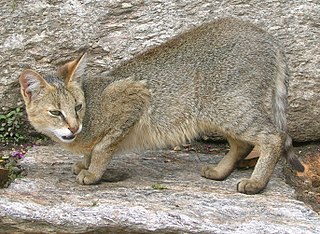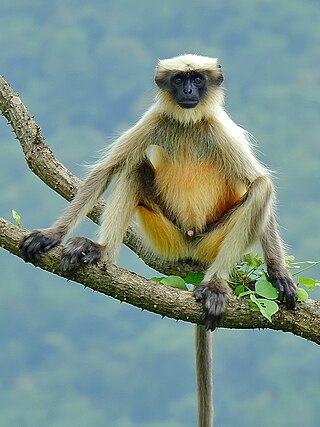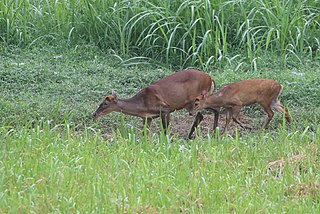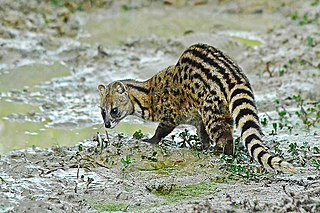
The jungle cat, also called reed cat, swamp cat and jungle lynx, is a medium-sized cat native to the Middle East, the Caucasus, South and Southeast Asia and southern China. It inhabits foremost wetlands like swamps, littoral and riparian areas with dense vegetation. It is listed as Least Concern on the IUCN Red List, and is mainly threatened by destruction of wetlands, trapping and poisoning.

The klipspringer is a small antelope found in eastern and southern Africa. The sole member of its genus and subfamily/tribe, the klipspringer was first described by German zoologist Eberhard August Wilhelm von Zimmermann in 1783. The klipspringer is a small, sturdy antelope; it reaches 43–60 centimetres at the shoulder and weighs from 8 to 18 kilograms. The coat of the klipspringer, yellowish gray to reddish brown, acts as an efficient camouflage in its rocky habitat. Unlike most other antelopes, the klipspringer has a thick and coarse coat with hollow, brittle hairs. The horns, short and spiky, typically measure 7.5–9 cm.

Gray langurs, also called are Old World monkeys native to the Indian subcontinent constituting the genus Semnopithecus. Traditionally only one species Semnopithecus entellus was recognized, but since about 2001, additional species have been recognized. The taxonomy has been in flux, but currently eight species are recognized.

The pompadour green pigeon is a pigeon species complex. It is widespread in forests of southern and southeast Asia. Many authorities have split the pompadour green pigeon into multiple species, which are listed below:

The bar-winged flycatcher-shrike is a small passerine bird usually placed in the Vangidae. It is found in the forests of tropical southern Asia from the Himalayas and hills of southern India to Indonesia. Mainly insectivorous it is found hunting in the mid-canopy of forests, often joining mixed-species foraging flocks. They perch upright and have a distinctive pattern of black and white, males being more shiny black than the females. In some populations the colour of the back is brownish while others have a dark wash on the underside.

The purple-faced langur, also known as the purple-faced leaf monkey, is a species of Old World monkey that is endemic to Sri Lanka. The animal is a long-tailed arboreal species, identified by a mostly brown appearance, dark face and a very shy nature. The species was once highly prevalent, found in suburban Colombo and the "wet zone" villages, but rapid urbanization has led to a significant decrease in the population level of the monkeys. It had traditionally been classified within the lutung genus Trachypithecus but was moved to the genus Semnopithecus based on DNA evidence indicating that is it more closely related to the gray langurs.

The spot-bellied eagle-owl, also known as the forest eagle-owl is a large bird of prey with a formidable appearance. It is a forest-inhabiting species found in the Indian Subcontinent and Southeast Asia. This species is considered part of a superspecies with the barred eagle-owl, which looks quite similar but is allopatric in distribution.

The sambar is a large deer native to the Indian subcontinent, South China and Southeast Asia that is listed as a vulnerable species on the IUCN Red List since 2008. Populations have declined substantially due to severe hunting, local insurgency, and industrial exploitation of habitat.

The chital or cheetal, also known as the spotted deer, chital deer and axis deer, is a deer species native to the Indian subcontinent. It was first described and given a binomial name by German naturalist Johann Christian Polycarp Erxleben in 1777. A moderate-sized deer, male chital reach 90 cm (35 in) and females 70 cm (28 in) at the shoulder. While males weigh 70–90 kg (150–200 lb), females weigh around 40–60 kg (88–132 lb). It is sexually dimorphic; males are larger than females, and antlers are present only on males. The upper parts are golden to rufous, completely covered in white spots. The abdomen, rump, throat, insides of legs, ears, and tail are all white. The antlers, three-pronged, are nearly 1 m long.

The golden jackal, also called common jackal, is a wolf-like canid that is native to Southeast Europe, Central Asia, Western Asia, South Asia, and regions of Southeast Asia. The golden jackal's coat varies in color from a pale creamy yellow in summer to a dark tawny beige in winter. It is smaller and has shorter legs, a shorter tail, a more elongated torso, a less-prominent forehead, and a narrower and more pointed muzzle than the Arabian wolf. It is listed as Least Concern on the IUCN Red List due to its widespread distribution and high density in areas with plenty of available food and optimum shelter.

The Southern red muntjac is a deer species native to Southeast Asia. It was formerly known as the Indian muntjac or the common muntjac before the species was taxonomically revised to represent only populations of Sunda and perhaps Malaysia. The other populations being attributed to this species are now attributed to Muntiacus vaginalis. Muntjacs are also referred to as barking deer. It is listed as Least Concern on the IUCN Red List.

The grizzled giant squirrel is a large tree squirrel in the genus Ratufa found in the highlands of the Central and Uva provinces of Sri Lanka, and in patches of riparian forest along the Kaveri River and in the hill forests of Karnataka, Tamil Nadu and Kerala states of southern India. The International Union for Conservation of Nature (IUCN) lists the species as near threatened due to habitat loss and hunting.

The stripe-necked mongoose is a mongoose species native to forests and shrublands from southern India to Sri Lanka.

The small Indian civet is a civet native to South and Southeast Asia. It is listed as Least Concern on the IUCN Red List because of its widespread distribution, widespread habitat use and healthy populations living in agricultural and secondary landscapes of many range states.

The slender lorises (Loris) are a genus of loris native to India and Sri Lanka. The genus comprises two species, the red slender loris found in Sri Lanka and the gray slender loris from Sri Lanka and India. Slender lorises spend most of their life in trees, traveling along the tops of branches with slow and precise movements. They are found in tropical rainforests, scrub forests, semi-deciduous forests, and swamps. The primates have lifespans of approximately 15 years and are nocturnal. Slender lorises generally feed on insects, reptiles, plant shoots, and fruit.

The gray slender loris is a species of primate in the family Loridae. It is native to India and Sri Lanka and inhabits subtropical and tropical dry forests and subtropical or tropical moist lowland forests. It is threatened by habitat loss.

The northern plains gray langur, also known as the sacred langur, Bengal sacred langur and Hanuman langur, is a species of primate in the family Cercopithecidae.

The Indian giant flying squirrel, also called the large brown flying squirrel or the common giant flying squirrel, is a species of rodent in the family Sciuridae. It is capable of gliding flight using a skin membrane stretched between front and hind legs. It is found in mainland Southeast and South Asia, and southern and central China.

The Indian blackbird is a member of the thrush family Turdidae. It was formerly considered a subspecies of the common blackbird. It is found only in India and Sri Lanka. The subspecies from most of the Indian subcontinent, simillimus, nigropileus, bourdilloni and spencei, are small, only 19–20 centimetres long, and have broad eye-rings. They also differ in proportions, wing formula, egg colour and voice from the common blackbird.

The tufted gray langur, also known as Madras gray langur, and Coromandel sacred langur, is an Old World monkey, one of the species of langurs. This, like other gray langurs, is mainly a leaf-eating monkey. It is found in southeast India and Sri Lanka. It is one of three Semnopithecus species named after characters from The Iliad, S. hector and S. ajax being the others. In Sinhala it is known as හැලි වදුරා.























